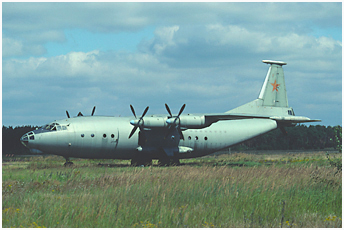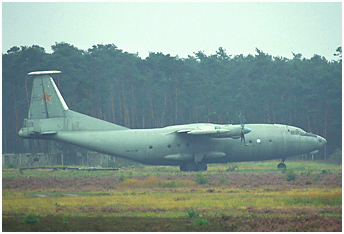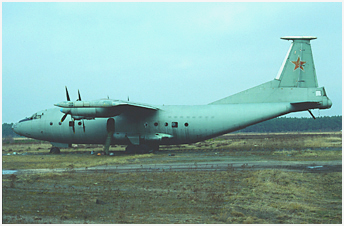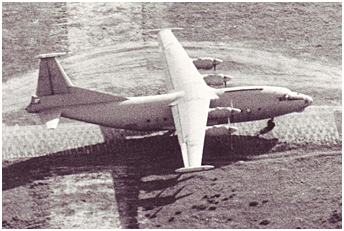 Un seul Antonov An-12A (19 rouge, c/n 9900902) - construit à Irkoutsk - a été converti en poste de commandement volant
(Vozdouchniy Kommandniy Pounkt), redésigné pour la circonstance
An-12VKP Zebra. Cet avion se distinguait immédiatement de ses congénères grâce aux trois carénages en forme de cigares
situés en bouts d'ailes et au sommet de la dérive. Ces derniers abritaient les antennes HF de la suite de communications
sécurisées. De plus, deux longues antennes filaires horizontales couraient à partir du bord de fuite des ailes,
sur le fuselage arrière. Un compartiment ou un container pressurisé se trouvait en soute et servait de "bureau de guerre"
aux officiers supérieurs, le restant du fuselage recevant les équipements de codage/décodage et de communications. L'An-12VKP
fut testé à Joukovsky, dépourvu de son code tactique. Ce poste de commandement aéroporté resta unique.
Un seul Antonov An-12A (19 rouge, c/n 9900902) - construit à Irkoutsk - a été converti en poste de commandement volant
(Vozdouchniy Kommandniy Pounkt), redésigné pour la circonstance
An-12VKP Zebra. Cet avion se distinguait immédiatement de ses congénères grâce aux trois carénages en forme de cigares
situés en bouts d'ailes et au sommet de la dérive. Ces derniers abritaient les antennes HF de la suite de communications
sécurisées. De plus, deux longues antennes filaires horizontales couraient à partir du bord de fuite des ailes,
sur le fuselage arrière. Un compartiment ou un container pressurisé se trouvait en soute et servait de "bureau de guerre"
aux officiers supérieurs, le restant du fuselage recevant les équipements de codage/décodage et de communications. L'An-12VKP
fut testé à Joukovsky, dépourvu de son code tactique. Ce poste de commandement aéroporté resta unique.
 L'avion de ligne Iliouchine Il-18D "Coot" lui fut en effet préféré en raison de son fuselage entièrement pressurisé.
Le quadrimoteur d'Iliouchine donna ainsi naissance aux conversions Il-22 Bizon et Il-22M Zebra "Coot-B".
L'avion de ligne Iliouchine Il-18D "Coot" lui fut en effet préféré en raison de son fuselage entièrement pressurisé.
Le quadrimoteur d'Iliouchine donna ainsi naissance aux conversions Il-22 Bizon et Il-22M Zebra "Coot-B".
L'An-12 continua ensuite à voler dans les rangs de l'Institut de recherches en vol (Letno-Issledovatelskiy Institout - LII) de Joukovsky, où, en 1975, il servit de banc d'essai pour le treuil BLT-5 de l'antenne filaire enroulable - d'une longueur de 2.500 mètres - du système de communication VLF (Very Low Frequency) alors en cours de développement pour le Toupolev Tu-142MR. De plus, une véritable toile d'araignée d'antennes joignait qui le fuselage, qui les ailes à la dérive verticale, le tout constituant autant d'antennes permettant de tester les radios VLF destinées à communiquer avec les sous-marins nucléaires lanceurs d'engins en plongée.
L'An-12VKP aurait peut-être ensuite volé au sein de la 16.VA, faisant fonction de poste de commandement volant
ou de simple avion de transport. Quoi qu'il en fut, sa carrière
se termina à Mahlwinkel durant l'hiver 1991-92 après un atterrissage brutal qui endommagea sérieusement sa structure.
(Adapté d'après "Antonov An-12 Cub" par Yefim Gordon et Dmitriy Komissarov, Crowood 2004)
Parqué sur le côté au bout d'un taxiway, le Zebra se déteriora lentement jusqu'à ce qu'il soit finalement ferraillé au printemps 1995,
le projet de le transformer en restaurant ayant finalement été abandonné.
An-12VKP airborne command post
 A single Irkutsk-built An-12A (19 Red, c/n 9900902) was converted into an airborne command post
(Vozdushniy Kommandniy Punkt) version designated
An-12VKP Zebra. The aircraft could be immediately recognised by three cigar-shaped fairings at the wingtips and atop
the fin which housed antennas associated with the secure HF communications suite. Additionally, long "towel rail" aerials ran
along the upper and lower fuselage sides from the wing trailing edge to a point in line with the front end of the fin fillet.
Obviously a pressurised compartment used as a 'war room' by Army commanders was provided in the freight hold, as was a
communications and encoding/decoding equipment bay. No longer wearing a tactical code or a civil registration, the An-12VKP was
tested at LII in Zhukovskiy. The aircraft remained a one-off because the Ilyushin Il-18D Coot airliner with its
completely pressurised fuselage was far better suited for conversion to the ABCP rôle - a fact which let to the development
of the Il-22 Bizon and the Il-22M Zebra "Coot-B" which entered production and service with the Soviet Air Force in substantial numbers.
A single Irkutsk-built An-12A (19 Red, c/n 9900902) was converted into an airborne command post
(Vozdushniy Kommandniy Punkt) version designated
An-12VKP Zebra. The aircraft could be immediately recognised by three cigar-shaped fairings at the wingtips and atop
the fin which housed antennas associated with the secure HF communications suite. Additionally, long "towel rail" aerials ran
along the upper and lower fuselage sides from the wing trailing edge to a point in line with the front end of the fin fillet.
Obviously a pressurised compartment used as a 'war room' by Army commanders was provided in the freight hold, as was a
communications and encoding/decoding equipment bay. No longer wearing a tactical code or a civil registration, the An-12VKP was
tested at LII in Zhukovskiy. The aircraft remained a one-off because the Ilyushin Il-18D Coot airliner with its
completely pressurised fuselage was far better suited for conversion to the ABCP rôle - a fact which let to the development
of the Il-22 Bizon and the Il-22M Zebra "Coot-B" which entered production and service with the Soviet Air Force in substantial numbers.
 The Antonov continued to fly with the Flight Research Institute (Letno-Issledovatelskiy Institut - LII) at Zhukovskiy where, in 1975, it was used as a testbed
for the BLT-5 winch and its 2.500 metres long VLF antenna developped for the Tupolev Tu-142MR. Additionally, a forest of
long VLF antennas run from the wings and fuselage upper surfaces to the tail fin. VLF radios were developed to contact
nuclear submarines cruising under the surface.
The Antonov continued to fly with the Flight Research Institute (Letno-Issledovatelskiy Institut - LII) at Zhukovskiy where, in 1975, it was used as a testbed
for the BLT-5 winch and its 2.500 metres long VLF antenna developped for the Tupolev Tu-142MR. Additionally, a forest of
long VLF antennas run from the wings and fuselage upper surfaces to the tail fin. VLF radios were developed to contact
nuclear submarines cruising under the surface.
Later the An-12VKP put in an appearance in East Germany, possibly operating for the Soviet 16th Air Army either as a flying command post or a transport aircraft.
According to press reports, in the winter of 1991-92 the aircraft was damaged beyond repair in a hard landing at Mahlwinkel airbase.
(Adapted from "Antonov An-12 Cub" by Yefim Gordon and Dmitriy Komissarov, Crowood 2004)
The aircraft was parked on the side of a taxiway at the far end of the airfield where it slowly deteriorated. The project to
convert the Antonov into a restaurant failed and it was finally scrapped in the spring of 1995.
 |
Plan du site - Sitemap |  |
